2013 SUBARU TRIBECA fuel cap
[x] Cancel search: fuel capPage 289 of 420

8-12Driving tips/Loading your vehicle
Loading your vehicle
WARNING
Never allow passengers to ride on a
folded rear seatback or in the cargo
area. Doing so may result in serious
injury.
WARNING
. Never stack luggage or other
cargo higher than the top of the
seatback because it could tumble
forward and injure passengers in
the event of a sudden stop or
accident. Keep luggage or cargo
low, as close to the floor as possible.
. When you carry something inside
the vehicle, secure it whenever
you can to prevent it from being
thrown around inside the vehicle
during sudden stops, sharp turns
or in an accident.
. Do not pile heavy loads on the
roof. These loads raise the vehi-cle ’s center of gravity and make it
more prone to tip over.
. Secure lengthy items properly to
prevent them from shooting for-
ward and causing serious injury
during a sudden stop.
. Never exceed the maximum load
limit. If you do, some parts on
your vehicle can break, or it can
change the way your vehicle
handles. This could result in loss
of control and cause personal
injury. Also, overloading can
shorten the life of your vehicle.
. Do not place anything on the
extended luggage cover. Such
items could tumble forward in
the event of a sudden stop or a
collision. This could cause ser-
ious injury.
CAUTION
Do not carry spray cans, containers
with flammable or corrosive liquids
or any other dangerous items inside
the vehicle.
NOTE
For better fuel economy, do not carry
unneeded cargo. & Vehicle capacity weight
Page 290 of 420
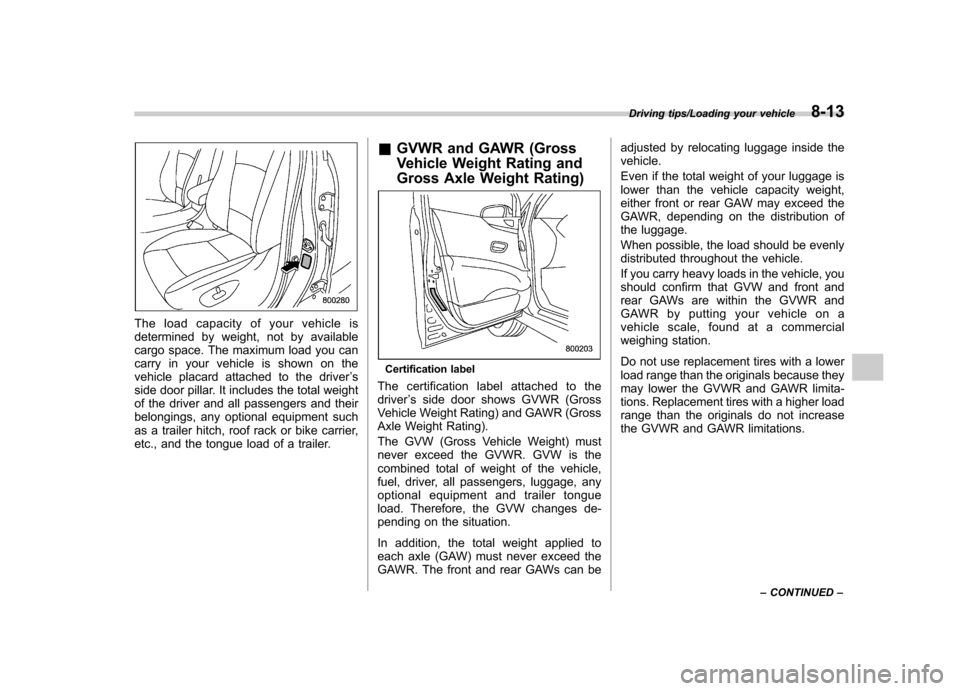
The load capacity of your vehicle is
determined by weight, not by available
cargo space. The maximum load you can
carry in your vehicle is shown on the
vehicle placard attached to the driver’s
side door pillar. It includes the total weight
of the driver and all passengers and their
belongings, any optional equipment such
as a trailer hitch, roof rack or bike carrier,
etc., and the tongue load of a trailer. &
GVWR and GAWR (Gross
Vehicle Weight Rating and
Gross Axle Weight Rating)
Certification label
The certification label attached to the driver ’s side door shows GVWR (Gross
Vehicle Weight Rating) and GAWR (Gross
Axle Weight Rating).
The GVW (Gross Vehicle Weight) must
never exceed the GVWR. GVW is the
combined total of weight of the vehicle,
fuel, driver, all passengers, luggage, any
optional equipment and trailer tongue
load. Therefore, the GVW changes de-
pending on the situation.
In addition, the total weight applied to
each axle (GAW) must never exceed the
GAWR. The front and rear GAWs can be adjusted by relocating luggage inside thevehicle.
Even if the total weight of your luggage is
lower than the vehicle capacity weight,
either front or rear GAW may exceed the
GAWR, depending on the distribution of
the luggage.
When possible, the load should be evenly
distributed throughout the vehicle.
If you carry heavy loads in the vehicle, you
should confirm that GVW and front and
rear GAWs are within the GVWR and
GAWR by putting your vehicle on a
vehicle scale, found at a commercial
weighing station.
Do not use replacement tires with a lower
load range than the originals because they
may lower the GVWR and GAWR limita-
tions. Replacement tires with a higher load
range than the originals do not increase
the GVWR and GAWR limitations.
Driving tips/Loading your vehicle8-13
– CONTINUED –
Page 340 of 420
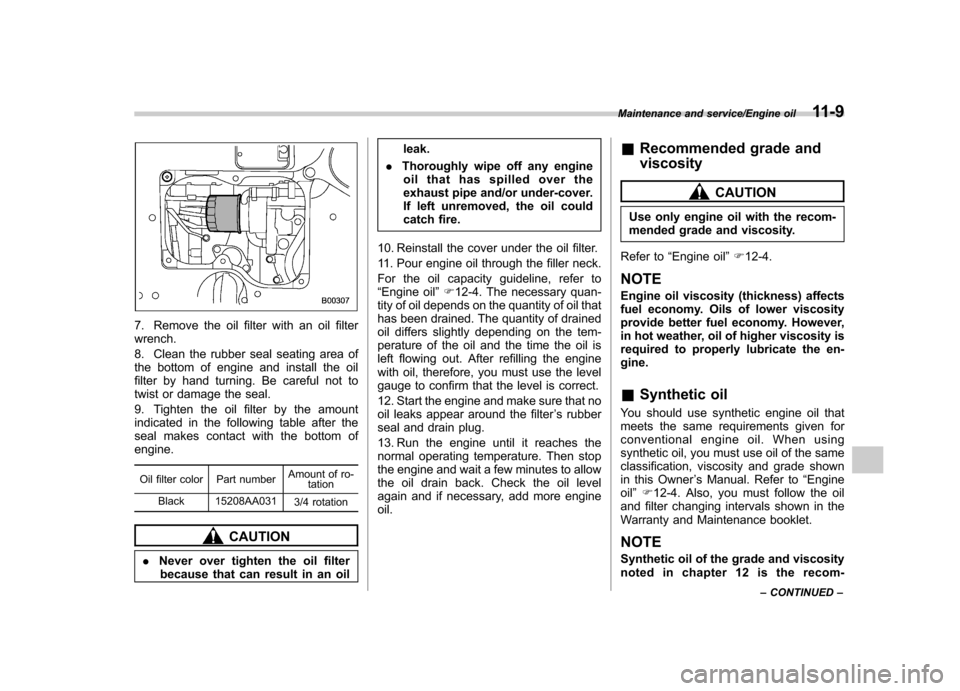
7. Remove the oil filter with an oil filter wrench.
8. Clean the rubber seal seating area of
the bottom of engine and install the oil
filter by hand turning. Be careful not to
twist or damage the seal.
9. Tighten the oil filter by the amount
indicated in the following table after the
seal makes contact with the bottom ofengine.Oil filter color Part number Amount of ro-
tation
Black 15208AA031 3/4 rotation
CAUTION
. Never over tighten the oil filter
because that can result in an oil leak.
. Thoroughly wipe off any engine
oil that has spilled over the
exhaust pipe and/or under-cover.
If left unremoved, the oil could
catch fire.
10. Reinstall the cover under the oil filter.
11. Pour engine oil through the filler neck.
For the oil capacity guideline, refer to “ Engine oil ”F 12-4. The necessary quan-
tity of oil depends on the quantity of oil that
has been drained. The quantity of drained
oil differs slightly depending on the tem-
perature of the oil and the time the oil is
left flowing out. After refilling the engine
with oil, therefore, you must use the level
gauge to confirm that the level is correct.
12. Start the engine and make sure that no
oil leaks appear around the filter ’s rubber
seal and drain plug.
13. Run the engine until it reaches the
normal operating temperature. Then stop
the engine and wait a few minutes to allow
the oil drain back. Check the oil level
again and if necessary, add more engineoil. &
Recommended grade and viscosity
CAUTION
Use only engine oil with the recom-
mended grade and viscosity.
Refer to “Engine oil ”F 12-4.
NOTE
Engine oil viscosity (thickness) affects
fuel economy. Oils of lower viscosity
provide better fuel economy. However,
in hot weather, oil of higher viscosity is
required to properly lubricate the en-gine. & Synthetic oil
You should use synthetic engine oil that
meets the same requirements given for
conventional engine oil. When using
synthetic oil, you must use oil of the same
classification, viscosity and grade shown
in this Owner ’s Manual. Refer to “Engine
oil ”F 12-4. Also, you must follow the oil
and filter changing intervals shown in the
Warranty and Maintenance booklet.
NOTE
Synthetic oil of the grade and viscosity
noted in chapter 12 is the recom-
Maintenance and service/Engine oil11-9
– CONTINUED –
Page 342 of 420

&Engine coolant
! Checking the coolant level
Check the coolant level at each fuel stop.
1. Check the coolant level on the outside
of the reservoir while the engine is cool.
2. If the level is close to or lower than the “LOW ”level mark, add coolant up to the
“ FULL ”level mark. If the reserve tank is
empty, remove the radiator cap and refill
as required.
3. After refilling the reserve tank and the
radiator, reinstall the caps and check that
the rubber gaskets inside the radiator cap
are in the proper position.
CAUTION
. Be careful not to spill engine
coolant when adding it. If coolant
touches the exhaust pipe, it may
cause a bad smell, smoke, and/or
a fire. If engine coolant gets on
the exhaust pipe, be sure to wipe
it off. .
Do not splash the engine coolant
over painted parts. The alcohol
contained in the engine coolant
may damage the paint surface.
! Changing the coolant
It may be difficult to change the coolant.
Have the coolant changed by your
SUBARU dealer if necessary.
The coolant should be changed according
to the maintenance schedule in the“ Warranty and Maintenance Booklet ”.
Maintenance and service/Cooling system11-11
Page 378 of 420

&Fuel
Fuel requirement Fuel tank capacity
Unleaded gasoline with 87 AKI (90 RON) or higher 16.9 US gal (64 liters, 14.1 Imp gal)
For more details, refer to “Fuel ”F 7-2.
Specifications/Specifications12-3
– CONTINUED –
Page 397 of 420
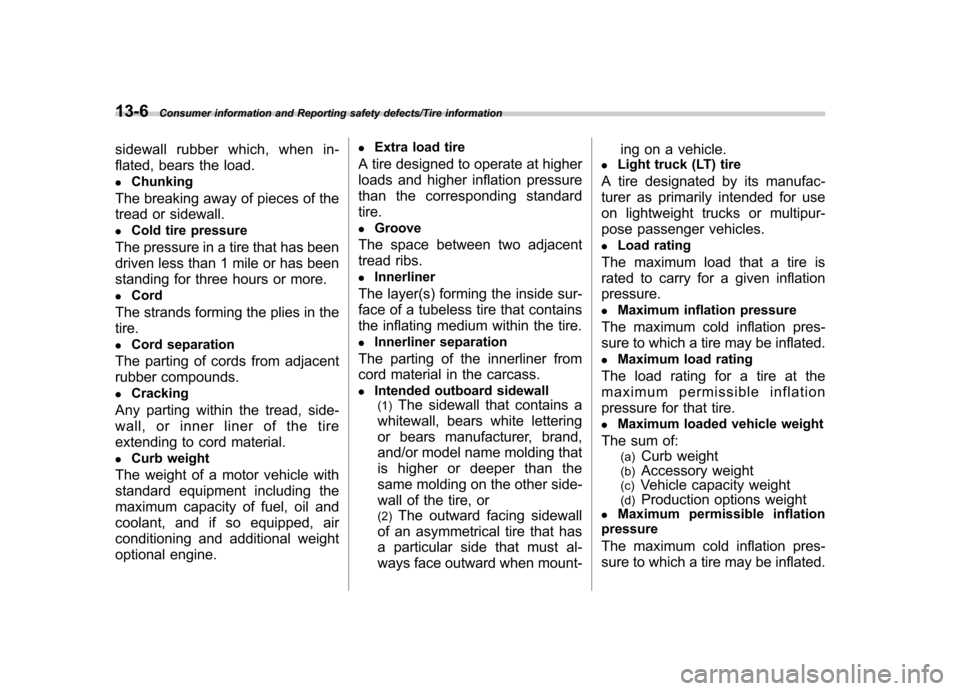
13-6Consumer information and Reporting safety defects/Tire information
sidewall rubber which, when in-
flated, bears the load..Chunking
The breaking away of pieces of the
tread or sidewall.. Cold tire pressure
The pressure in a tire that has been
driven less than 1 mile or has been
standing for three hours or more.. Cord
The strands forming the plies in the tire. . Cord separation
The parting of cords from adjacent
rubber compounds.. Cracking
Any parting within the tread, side-
wall, or inner liner of the tire
extending to cord material. . Curb weight
The weight of a motor vehicle with
standard equipment including the
maximum capacity of fuel, oil and
coolant, and if so equipped, air
conditioning and additional weight
optional engine. .
Extra load tire
A tire designed to operate at higher
loads and higher inflation pressure
than the corresponding standardtire. . Groove
The space between two adjacent
tread ribs.. Innerliner
The layer(s) forming the inside sur-
face of a tubeless tire that contains
the inflating medium within the tire. . Innerliner separation
The parting of the innerliner from
cord material in the carcass.. Intended outboard sidewall
(1) The sidewall that contains a
whitewall, bears white lettering
or bears manufacturer, brand,
and/or model name molding that
is higher or deeper than the
same molding on the other side-
wall of the tire, or (2) The outward facing sidewall
of an asymmetrical tire that has
a particular side that must al-
ways face outward when mount- ing on a vehicle.
. Light truck (LT) tire
A tire designated by its manufac-
turer as primarily intended for use
on lightweight trucks or multipur-
pose passenger vehicles. . Load rating
The maximum load that a tire is
rated to carry for a given inflationpressure.. Maximum inflation pressure
The maximum cold inflation pres-
sure to which a tire may be inflated.. Maximum load rating
The load rating for a tire at the
maximum permissible inflation
pressure for that tire.. Maximum loaded vehicle weight
The sum of: (a) Curb weight
(b) Accessory weight
(c) Vehicle capacity weight
(d) Production options weight
. Maximum permissible inflation
pressure
The maximum cold inflation pres-
sure to which a tire may be inflated.
Page 412 of 420
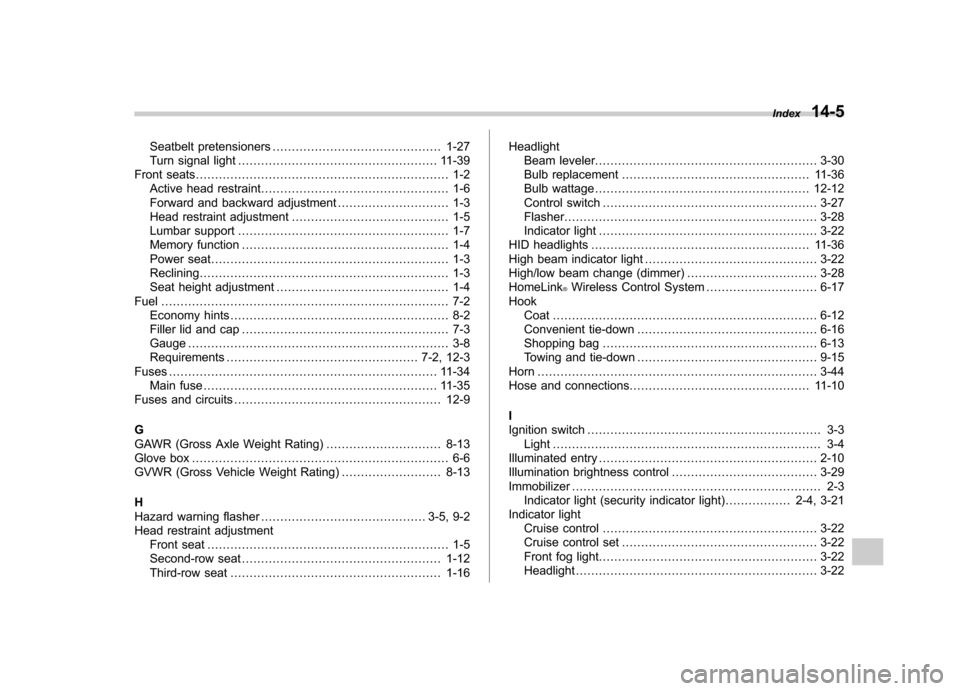
Seatbelt pretensioners............................................ 1-27
Turn signal light .................................................... 11-39
Front seats .................................................................. 1-2
Active head restraint ................................................. 1-6
Forward and backward adjustment ............................. 1-3
Head restraint adjustment ......................................... 1-5
Lumbar support ....................................................... 1-7
Memory function ...................................................... 1-4
Power seat .............................................................. 1-3
Reclining ................................................................. 1-3
Seat height adjustment ............................................. 1-4
Fuel ........................................................................... 7-2
Economy hints ......................................................... 8-2
Filler lid and cap ...................................................... 7-3
Gauge .................................................................... 3-8
Requirements .................................................. 7-2, 12-3
Fuses ...................................................................... 11-34
Main fuse ............................................................. 11-35
Fuses and circuits ...................................................... 12-9
G
GAWR (Gross Axle Weight Rating) .............................. 8-13
Glove box ................................................................... 6-6
GVWR (Gross Vehicle Weight Rating) .......................... 8-13
H
Hazard warning flasher ........................................... 3-5, 9-2
Head restraint adjustment Front seat ............................................................... 1-5
Second-row seat .................................................... 1-12
Third-row seat ....................................................... 1-16 Headlight
Beam leveler. ......................................................... 3-30
Bulb replacement ................................................. 11-36
Bulb wattage ........................................................ 12-12
Control switch ........................................................ 3-27
Flasher .................................................................. 3-28
Indicator light ......................................................... 3-22
HID headlights ......................................................... 11-36
High beam indicator light ............................................. 3-22
High/low beam change (dimmer) .................................. 3-28
HomeLink
®Wireless Control System ............................. 6-17
Hook Coat ..................................................................... 6-12
Convenient tie-down ............................................... 6-16
Shopping bag ........................................................ 6-13
Towing and tie-down ............................................... 9-15
Horn ......................................................................... 3-44
Hose and connections ............................................... 11-10
I
Ignition switch ............................................................. 3-3
Light ...................................................................... 3-4
Illuminated entry ......................................................... 2-10
Illumination brightness control ...................................... 3-29
Immobilizer ................................................................. 2-3
Indicator light (security indicator light) ................. 2-4, 3-21
Indicator light
Cruise control ........................................................ 3-22
Cruise control set ................................................... 3-22
Front fog light ......................................................... 3-22
Headlight ............................................................... 3-22 Index
14-5
Page 417 of 420
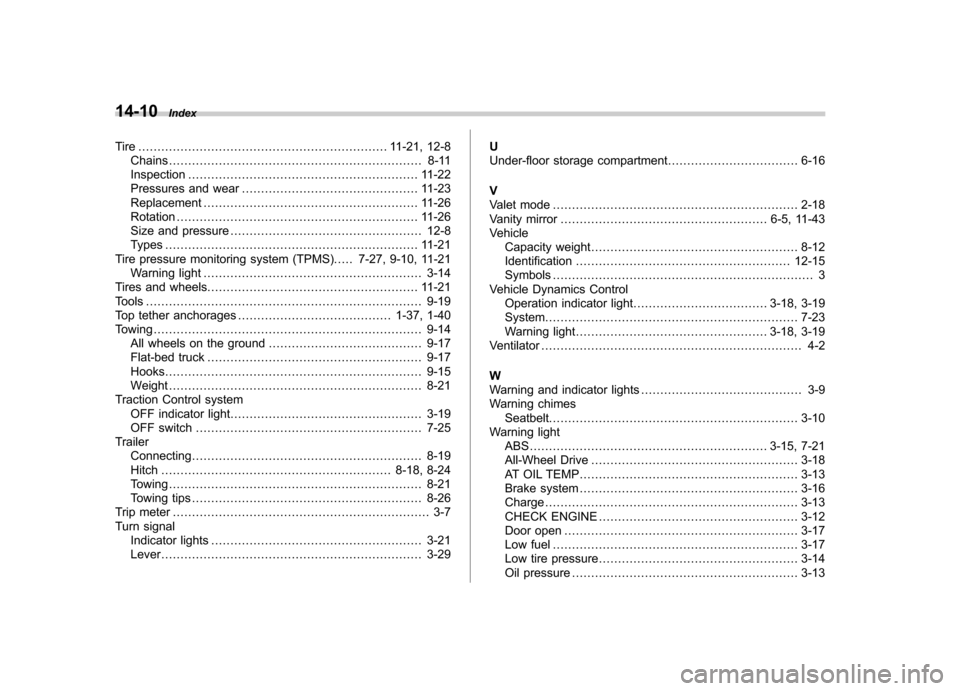
14-10Index
Tire ................................................................. 11-21, 12-8 Chains .................................................................. 8-11
Inspection ............................................................ 11-22
Pressures and wear .............................................. 11-23
Replacement ........................................................ 11-26
Rotation ............................................................... 11-26
Size and pressure .................................................. 12-8
Types .................................................................. 11-21
Tire pressure monitoring system (TPMS). .... 7-27, 9-10, 11-21
Warning light ......................................................... 3-14
Tires and wheels. ...................................................... 11-21
Tools ........................................................................ 9-19
Top tether anchorages ........................................ 1-37, 1-40
Towing ...................................................................... 9-14
All wheels on the ground ........................................ 9-17
Flat-bed truck ........................................................ 9-17
Hooks ................................................................... 9-15
Weight.................................................................. 8-21
Traction Control system OFF indicator light .................................................. 3-19
OFF switch ........................................................... 7-25
Trailer
Connecting ............................................................ 8-19
Hitch ............................................................ 8-18, 8-24
Towing .................................................................. 8-21
Towing tips ............................................................ 8-26
Trip meter ................................................................... 3-7
Turn signal Indicator lights ....................................................... 3-21
Lever .................................................................... 3-29 U
Under-floor storage compartment
.................................. 6-16
V
Valet mode ................................................................ 2-18
Vanity mirror ...................................................... 6-5, 11-43
Vehicle Capacity weight ...................................................... 8-12
Identification ........................................................ 12-15
Symbols .................................................................... 3
Vehicle Dynamics Control
Operation indicator light ................................... 3-18, 3-19
System .................................................................. 7-23
Warning light .................................................. 3-18, 3-19
Ventilator .................................................................... 4-2
W
Warning and indicator lights .......................................... 3-9
Warning chimes
Seatbelt. ................................................................ 3-10
Warning light
ABS.............................................................. 3-15, 7-21
All-Wheel Drive ...................................................... 3-18
AT OIL TEMP ......................................................... 3-13
Brake system ......................................................... 3-16
Charge .................................................................. 3-13
CHECK ENGINE .................................................... 3-12
Door open ............................................................. 3-17
Low fuel ................................................................ 3-17
Low tire pressure .................................................... 3-14
Oil pressure ........................................................... 3-13